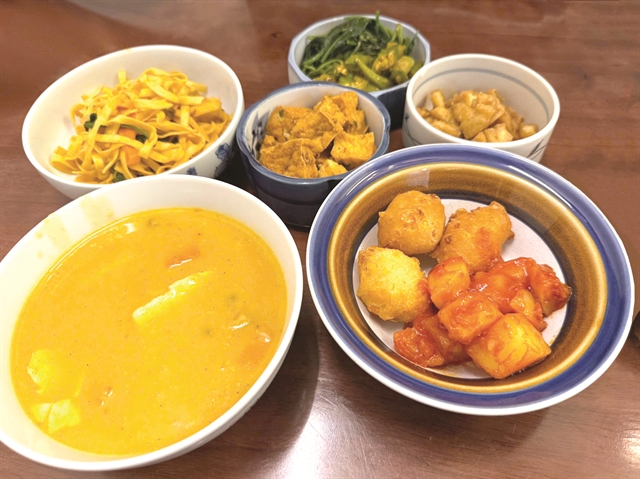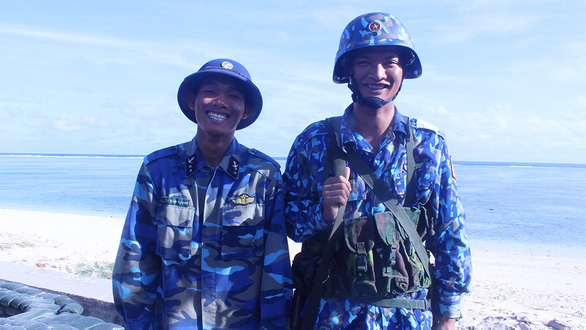 Society
Society

There are 41 ethnic minority soldiers working on Trường Sa Archipelago, including people of Chăm, Mường, Dao, Mông, Khmer, S’tiêng, Tày and Raglai ethnicities.

|
| Thập Văn Hoan (left) and Phạm Công Giáp with their happy smiles on the Sơn Ca Island. — Photo tuoitre.vn |
HÀ NỘI — Lieutenant Phạm Công Giáp and Thập Văn Hoan are two special soldiers working on the Sơn Ca (Sand Cay) Island.
They are special because they are some of the few ethnic people to step foot on Trường Sa (Spratly) Archipelago of Việt Nam, and because they volunteered to spend their youth in service of the nation.
Giáp is a Mường man from the central province of Thanh Hóa and Hoan is a Chăm man from the central-southern province of Ninh Thuận.
Sơn Ca is one of biggest islands of Trường Sa Archipelago off the central province of Khánh Hòa.
There are 41 ethnic minority soldiers working on Trường Sa Archipelago, including people of Chăm, Mường, Dao, Mông, Khmer, S’tiêng, Tày and Raglai ethnicities.
Lieutenant colonel Phạm Doãn Thảo, a commissar, told Tuổi trẻ (Youth) newspaper that Giáp and Hoan were exemplary soldiers.
“They are enthusiastic in their duty. Giáp is agile, hard-working and is able to do everything whereas Hoan is gentle with a fond smile and skill. Hoan can draw and decorate the notice board, make flower baskets, bicycles, star and bird models,” he said.
Lieutenant Phạm Công Giáp, 26, has worked on Sơn Ca Island since December 2018. After graduating from Army Officer College No 1, he worked for two years at the Naval Forces High Command Region 3. After that, he moved to the Naval Forces High Command Region 4 and then volunteered to go to Sơn Ca Island.
“The sea at Trường Sa Archipelago is much more beautiful than my imagination,” said Giáp.
Earlier, Giáp had seen programmes about Trường Sa on YouTube and television, and he understood how hard the work on the island would be. Both the sun and rain are severe on the island, and typhoons are also much more violent than inland.
“I’m young. I need practice and hardship to reach adulthood so I didn't hesitate,” said Giáp.
Giáp has welcomed two Tết (Lunar New Year) festivals on the island.
“My first Tết holiday on the island was very special,” said Giáp.
It was special because Giáp was responsible for presenting arms and guarding on New Year’s Eve.
“Not many people are assigned to guard on New Year’s Eve, moreover, it was a guardship at Trường Sa Archipelago. The moment was so sacred and moving for me. I was so proud and wanted to tell my parents immediately,” said Giáp.
“The work environment here has helped me be more mature and steadier,” he said.
Besides Giáp, Thập Văn Hoan is also an ethnic minority working on Sơn Ca Island.
Hoan, 20, is the last child in his family, so when he said that he would go to Trường Sa Archipelago, his family was very worried.
On the contrary with his family, Hoan was very eager to go to the island, which he had known via books and television only.
“I have dreamed of becoming a soldier since I was small. And I was the first person in my family to join the army,” said Hoan.
At first, Hoan was a little worried if he could do his duties or not.
Hoan remembered deeply the time he first entered the island. Everything was new, strange and interesting to him.
“I love watching the sunrise and sunset on the island. It was amazing and beautiful,” said Hoan.
Hoan said soldiers came from different provinces and cities, but all were united. People join activities together such as singing, baseball, tug of war and running.
“I have many good friends. My comrades all have a sense of humour and are ready to help each other,” said Hoan.
“I’m very proud that I have gone to Trường Sa. When I go to inland, I will tell every person about my life and comrades here,” he said. — VNS